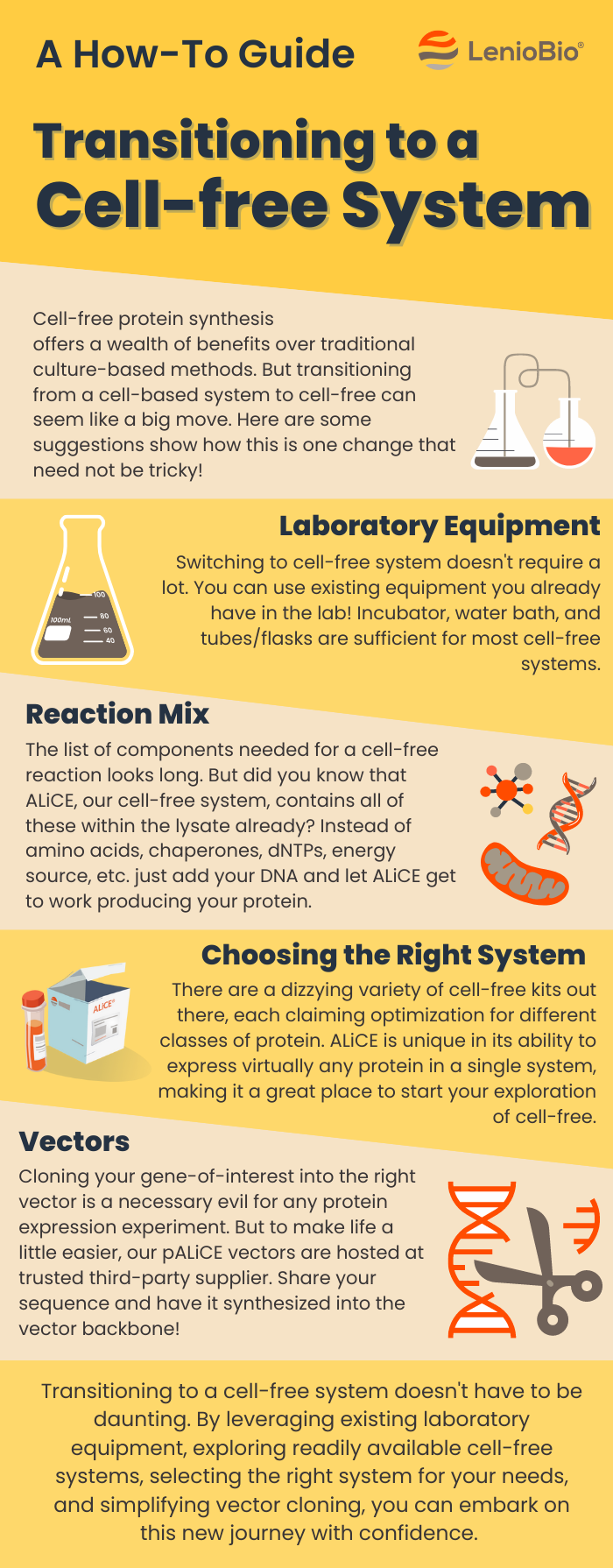Unlocking the Potential of Cell-Free Protein Expression: A Step-by-Step Transition Guide
In the field of protein production, the traditional approach of utilizing living cells for protein expression has long been the standard. However, recent advancements in cell-free protein expression systems have sparked immense interest and opened up new possibilities.
Cell-free protein expression offers a range of advantages, including faster protein production, enhanced control over experimental conditions, and the ability to express challenging proteins that may be difficult to produce in cell-based systems. However, making a change, whether in our daily lives or in the lab, can often feel overwhelming. We understand that stepping away from traditional cell-based technologies and exploring the realm of cell-free expression systems may raise some concerns. That's precisely why we've put together this comprehensive guide to help you navigate this transition, debunking myths along the way!
Whether you're a researcher looking to optimize protein production methods or an industry professional seeking to improve efficiency and scalability, this guide will provide you with valuable insights to make a successful transition.
1. Laboratory Equipment:
One common misconception is that switching to a cell-free system requires a complete overhaul of your lab setup. However, the truth is far from that. In fact, transitioning to a cell-free expression system can be seamless and cost-effective, as you can utilize the same equipment you are already using for cell culture.
Most cell-free systems require a fairly simple set of lab equipment. This includes basic items such as an incubator or shaking head block, a water bath for temperature control, and commonly used labware like Eppendorf tubes, falcon tubes, or Erlenmeyer flasks (depending on the scale of your reaction). These equipment and consumables are typically already present in most research or industry labs, making the transition to cell-free protein expression accessible without significant additional investments. By leveraging your existing resources, you can embrace the benefits of cell-free systems while minimizing the disruption to your lab routine and budget.
2. Reaction Mix:
Setting up a cell-free expression reaction may initially appear complex. If you Google what is needed, the list of components is pretty lengthy (amino acids, chaperones, dNTPs, energy source, etc.). However, did you know that there are readily available, out-of-the-box cell-free systems that contain many if not all of these components? Taking this a step further our ALiCE system includes all of these components in the lysate! This massively simplifies your experimental set-up – just add your DNA and set your cell-free system to work producing your protein!
3. Choosing the Right System:
The market offers a multitude of cell-free systems tailored to specific protein types and requirements. There are E. coli systems for producing prokaryotic proteins and various eukaryotic systems (HeLa, CHO, Insect) for your more complex proteins, each with their relative pros and cons. It can be overwhelming to determine which system is best for your needs. Our ALiCE system offers a single versatile solution, allowing you to produce any protein, from the simplest to the most complex all with a single kit, a perfect way to start exploring the world of cell-free protein expression!

4. Vectors:
Cloning and vector selection may seem like complex tasks, especially when transitioning to any new expression system. And unfortunately, cloning is still a necessary evil for cell-free expression systems, as with cell-based processes. However, to make life a little easier for you, our ALiCE vectors are hosted by trusted third-party suppliers – simply share the sequence of your protein of interest and have it synthesized directly into the vector backbone!
In conclusion, transitioning to a cell-free system doesn't have to be daunting. By leveraging existing laboratory equipment, exploring readily available cell-free systems, selecting the right system for your needs, and simplifying vector cloning, you can embark on this new journey with confidence.
Now that we have simplified the process, why not give cell-free systems a try? We invite you to read our White Paper, where we delve into how the new generation of cell-free systems is revolutionizing the field of cell-free expression. Discover the remarkable possibilities and exciting potential waiting for you!
Ready to Take the Leap?
Learn more about ALiCE
The technology behind ALiCE
ALiCE® is a eukaryotic cell-free protein expression harnessing the power of N. tabacum cells.
ALiCE® as a kit
ALiCE is available as a protein expression kit in three different sizes to suit your needs.
ALiCE® as a protein service
Leverage our team's expertise for your protein expression project with our end-to-end protein service.


